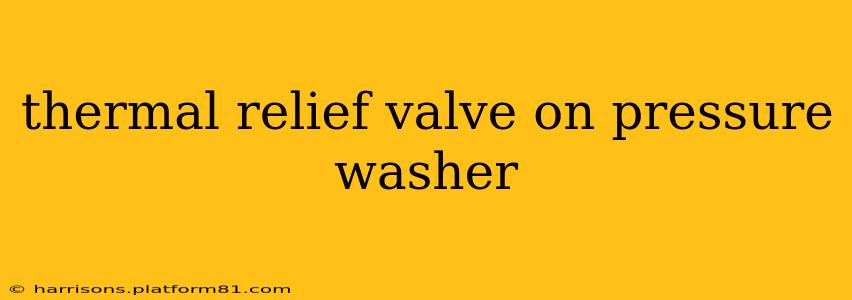Pressure washers are powerful cleaning machines, but their intense heat and pressure can pose safety risks. A crucial safety component is the thermal relief valve, designed to prevent catastrophic failures. This guide will delve into the function, importance, and troubleshooting of thermal relief valves in pressure washers.
What is a Thermal Relief Valve on a Pressure Washer?
A thermal relief valve, also known as a thermal relief valve or pressure relief valve (although the latter is often broader), is a safety device that automatically releases excess pressure and heat from a pressure washer's system. This prevents dangerous buildup that could lead to explosions, burns, or severe damage to the machine. It's a crucial fail-safe mechanism, particularly in hot water pressure washers where temperatures can reach significantly high levels. Think of it as a pressure safety valve designed specifically to release excess heat and pressure. The valve opens when the internal temperature or pressure surpasses a predetermined threshold.
How Does a Thermal Relief Valve Work?
The thermal relief valve typically operates on a combination of temperature and pressure. It's usually a spring-loaded valve; when the pressure or temperature exceeds a safe limit, the spring mechanism releases, allowing hot water and steam to escape. This prevents the system from reaching dangerously high pressures, protecting both the machine and the user. The precise mechanism varies slightly depending on the manufacturer and pressure washer model, but the core function remains the same: safety through pressure and temperature release.
Why is a Thermal Relief Valve Important?
The importance of a functioning thermal relief valve cannot be overstated. Without it, a pressure washer is susceptible to several severe issues:
- Explosions: Overpressurization can cause the pressure washer's components to burst, potentially leading to serious injuries from flying debris and scalding hot water.
- Burns: High-pressure hot water escaping from a ruptured component can cause severe burns.
- Equipment Damage: The intense pressure and heat can cause irreversible damage to the pump, hoses, and other internal components.
- Inoperability: A malfunctioning system, due to extreme pressure or heat build-up, can render your pressure washer unusable until repairs are made.
Regular inspection and maintenance of this vital safety component are essential for safe and reliable operation.
What Happens If My Thermal Relief Valve Malfunctions?
A malfunctioning thermal relief valve is a serious issue. If it fails to open when necessary, it will allow pressure and temperature to build beyond safe levels, increasing the risk of the problems listed above. Signs of a malfunctioning valve can include unusual noises from the pressure washer, decreased performance, or visible leakage of hot water or steam. Never attempt to operate a pressure washer with a suspected faulty thermal relief valve. Immediate repair or replacement is necessary.
How Often Should I Check My Thermal Relief Valve?
While there's no universally agreed-upon frequency, it’s wise to inspect your thermal relief valve at the beginning of each pressure washing season and after periods of prolonged storage. A visual check for damage or leaks is a good starting point. If you notice any signs of wear, damage, or leakage, replace the valve immediately. Always consult your pressure washer's user manual for specific recommendations.
Can I Repair a Thermal Relief Valve?
While some minor issues might seem fixable, thermal relief valves are generally considered to be replacement-only components. Attempting to repair one is generally not recommended due to the safety risks. The valves are precision-engineered to release pressure and heat at specific thresholds; improper repair can lead to inaccurate operation and potentially hazardous situations. Always replace a malfunctioning thermal relief valve with a genuine replacement part from the manufacturer.
Where is the Thermal Relief Valve Located?
The location of the thermal relief valve varies depending on the pressure washer model. Consult your owner’s manual for its specific location. It's often found near the pump or the hot water tank (if applicable).
This comprehensive guide provides insights into the importance and functionality of thermal relief valves in pressure washers. Prioritizing safety and regular maintenance ensures a long and safe lifespan for your pressure washer. Remember that your safety is paramount; always consult the manual for your specific model and seek professional help if you are uncertain about anything.
